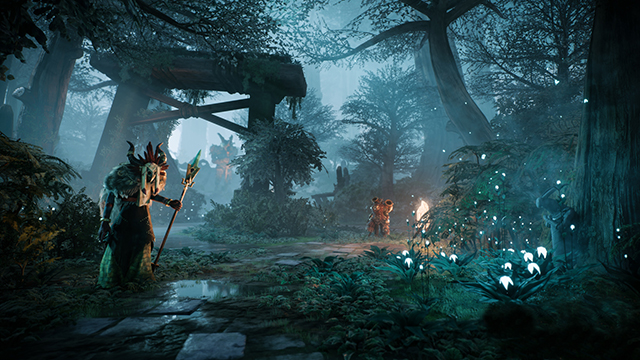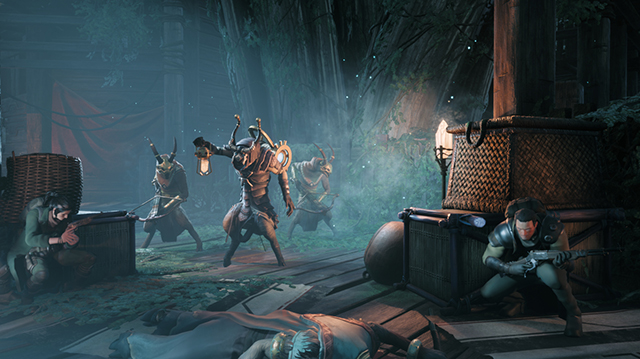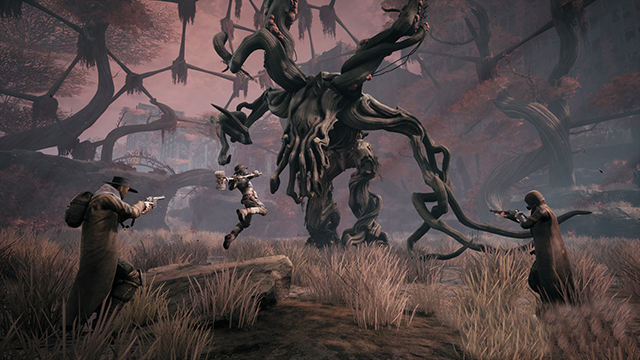Gunfire Games’ last game was a bit of a stinker. Darksiders 3 was not only broken and buggy, but also a weak imitation of From Software’s Souls games. Remnant: From the Ashes, the studio’s next title, is pulling from Dark Souls yet again but it’s doing so in a slightly different way. It’s a cooperative, procedurally-generated third-person loot shooter; a far cry from any Souls game. To explain that jump to a different genre, we sat down with Mike Maza, principle designer at Gunfire, to talk about the process of making a methodical shooter, its Soulsian roots, how long the game is, and more.
Game Revolution: Remnant is a co-op Souls-like shooter. What made you all want to make a game like this?
Mike Maza: That’s a tough one. We’ve always wanted to make a shooter that wasn’t a twitch shooter. A lot of us are fans of twitch shooters but we wanted to make a game where the combat was a lot more deliberate and brutal and challenging. There’s something about fighting through every inch of a level that speaks to us.
ALSO: Torchlight 2 Switch developer hints at Switch Pro while also discussing the porting process
And we are fans of games like Dark Souls and we understand what that game brought to the genre. Like it was OK for a game to be tough because gamers like a challenge. So we thought about taking that same concept and putting it to a shooter.
GR: But it still feels good to play since the animations aren’t as slow.
MM: Right. We didn’t want to punish the player by making everything feel like they were slogging through water. We wanted to make the controls responsive. We just wanted to focus the difficulty on the types of creatures that are attacking you, their combinations, hit points, and their special abilities that they can use on you to make your life miserable. And for you to learn from dying multiple times and figuring out how to defeat them. As you fight them, you learn what they do and you watch for cues and when you finally beat them for the first time, it’s like “Oh, I get it.”
There are over 120 creatures in the game between the base creatures, the champions, and the ginormous world bosses. And each of them have their own unique flavor and abilities and way to fight them. And the combinations of those guys will completely change the fight. So you have to not only learn individual creature attacks but [how they attack you] in concert.

GR: How do you craft so many monsters and make them all different?
MM: It’s not easy. I could try to boil it down to something that sounds really simple but it isn’t. At the end of the day. It’s an organic process. We look at every creature and ask what role it could fill. Sometimes our inspiration comes from seeing really cool concept art. And then you ask what role it would have. Sometimes it’s the other way around.
We did that process 120 times. That process is even more crazy complex when we start talking about champions and the world bosses that have these unique stage attacks. There are a lot of talented people at the studio and someone will always have an idea.
GR: So, lore-wise what are these creatures?
MM: Let me give you backstory first. It’s an alternate Earth history. The shit hit the fan roughly in the mid-1960s…
GR: Vietnam, am I right?
MM: Yeah [laughs]. But to make a long story short, archaeologists found these big crystals. They thought that since they were emanating some strange energy that it was some of zero-point energy system where they could have unlimited energy. So they sent them to a bunch of research stations. They found that these things weren’t actually energy generators but portals to other dimensions.
And they accidentally opened these portals and these monsters — the Root — came out and they overran the planet and drove us back to the Stone Age. So what’s left of mankind is a bunch of small tribes in a world full of these freakin’ monsters.
And so you are a character that is asked to figure out how this all happened. So through the course of the story, you actually journey through a bunch of different worlds and piece together this story about how this whole invasion started and how you can maybe stop them.

GR: Darksiders was never a cooperative game but Remnant is. Why not make it a single-player game like all of your other titles?
MM: A lot of us are huge co-op fans. We’ve wanted to make a co-op game since as far back as I could remember. So it was a natural progression.
When we started talking about this game initially, we we’re thinking that we could make this a badass single-player game but we could make it a badass co-op game? Because it’s fun to play with friends. At the end of the day, it’s a blast to play with your buddy and scream over the microphone. We wanted to create a game as difficult and challenging as Remnant but playable by a group of friends.
GR: Darksiders is also your team’s biggest and most well-known series but it seems so different. What did you learn from making that series that you could apply to Remnant: From the Ashes?
MM: Personally, and I think a lot of people in the studio feel the same way, I think the coolest thing about Darksiders was contemporary settings with fantasy themes. The whole idea of Darksiders is that it is our Earth turned into an angelic and demonic apocalypse. It’s totally fantasy.
And we pride ourselves with being able to merge modern environments with real, fantastic elements. We wanted to do the same thing for Remnant. We could have done the easy thing and said it was a zombie apocalypse on Earth. But that wouldn’t have been us. We want the fantastic and we wanted that fantastic to be the tapestry of the game.
GR: The game is mostly procedurally generated. Why go down that road and what does it add to the game?
MM: We wanted variety. The one thing that we wanted to do for a long time was to be able to come up with a system that could generate seamless environments. Don’t get me wrong; hand-crafted environments are amazing. But we wanted to generate a world and go, “What do I see now?” Whereas if all the levels are hand-crafted, you would know them all. You’d exactly what enemy would be around each corner. We didn’t want that.
This is a game about interdimensional creatures. It’s about this idea of jumping into the unknown so we wanted the world itself to be an unknown every time you step into it.

GR: So if it is procedural, is the game supposed to repeatable? Like are players supposed to grind the same missions as they go through the campaign?
MM: In the campaign, you’ll hit the same general story beats but everything in the middle — the events, creatures, dungeons, and loot — are all randomly generated every single time you generate a new campaign. So if you get all the way to the end of the campaign, which if you’re decent, is around 10 to 12 hours, you’re only going to see a third of the game. And this is because there are so many permutations of the random generation that you’re not going to see every quest, creature, or piece of loot. It behooves you play the campaign to play the campaign more than once so you can see all the content.
GR: It sounds like it’s more repeatable in that you beat it and play it again rather than playing the same missions through one elongated campaign.
MM: Yes. And your buddies can generate their own game and you can bounce back and forth into each other’s worlds. So they might have an event or boss that you’ve never seen before.
GR: It must be hard to make parts of a game that some people just won’t see.
MM: The way we think about that kind of stuff is that if people enjoyed the first presentation of your game and there’s more stuff for them to discover, then they’ll play it again and again. If you did your job right, they’ll see the content eventually. It’s OK if they don’t see it the first time around. It’s something for them and their friends to talk about next time they are in school or around the watercooler.
GR: This seems like a game ripe for DLC. Is there a roadmap all laid out?
MM: There will be DLC. We want to make all the DLC substantial and meaningful. We don’t want to piecemeal you with a little thing here and a little thing there. Every time we drop DLC, we want you to go “Oh my god, I need to get that.” It might be a whole new world or a set of new creatures or weapons. It has to be stuff that whenever we release it, people are going to say that it is worth it.











